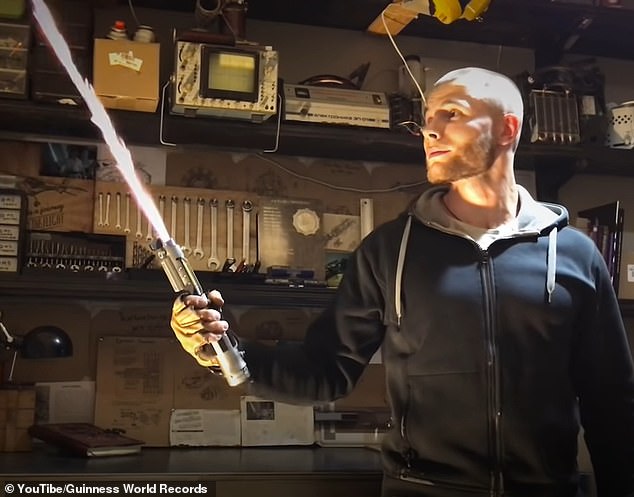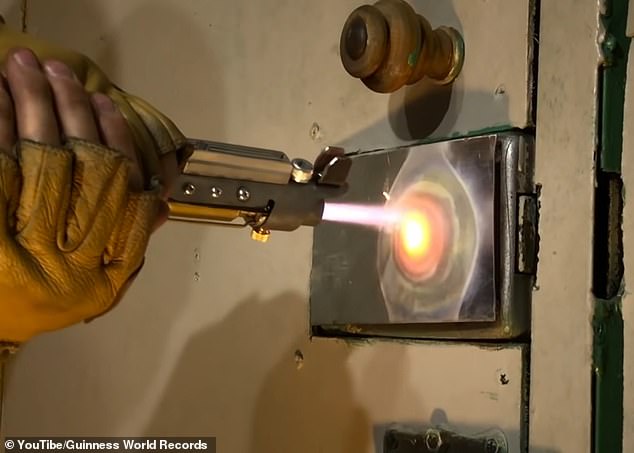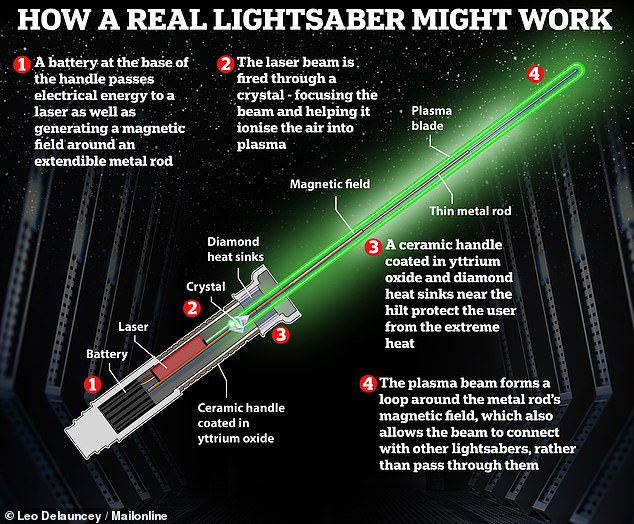They were described as “an elegant weapon from a more civilized time” in the first Star Wars film in 1977.
Since then, fans have dreamed of owning a real lightsaber: the colorful weapon that can cut through flesh or metal effortlessly.
Despite some impressive attempts by engineers, the quest to create a version identical to those in the movies may seem outside the realm of reality.
A scientist thinks it might be possible and has revealed his step-by-step guide to creating a lightsaber.
However, Dr Alex Baker, a chemist at the University of Warwick, warned MailOnline that the “superheated stick of burning death” may be too dangerous for the public to get their hands on.
Inside the handle, a battery near the bottom would pass electrical energy to a laser that would produce light energy, which in turn would be focused by a crystal to ionize the gas and produce plasma.
The blade of a lightsaber is made of “plasma”, the fourth state of matter after solid, liquid and gas.
According to Dr. Baker, a real lightsaber would take gas from the surrounding air and could ionize it into plasma.
Plasma is an ionized gas, which means that its atoms or molecules are not neutral, but carry an electrical charge.
It can also be fired into straight beams at very high temperatures, allowing it to cut steel.
YouTubers have already attempted to make their own plasma lightsabers, including Russia’s Alex Burkan, who made the world’s first retractable lightsaber in 2022.
However, his creation is nothing like the movies and the sword only fires for 30 seconds.
Meanwhile, Canadian James Hobson created his own version with a more durable blade, but that’s only because he got his power source from a connected backpack.
“People have made devices that generate a direct jet of plasma that eventually cools and de-ionises back into a gas,” Dr Baker told MailOnline.
“The length of the blades is limited by the distance they can eject a plasma jet, that is, how far an ionized gas can be fired before it cools and the electrons recombine with their ions.”
The problem is that plasma tends to dissipate if it is not contained in a magnetic field, so the blade would disappear shortly after igniting the lightsaber.

Russian YouTuber Alex Burkan made the world’s first retractable lightsaber in 2022. The blade has the ability to cut steel, but it only works for 30 seconds and doesn’t look much like the perfectly straight jet of color like in the movies.

Plasma is a stream of highly ironized particles, so Burkan’s lightsaber could also attract lightning and other high-voltage charges.
What’s more, if they didn’t have a magnetic field, two blades would simply pass each other instead of crashing into each other like in the movies.
Dr. Baker says this very important magnetic field could be emitted by a long, thin metal rod through which an electric current passes.
If shaped correctly, the magnetic field could hold a “loop” of plasma in place, but the rod would have to run the entire length of the blade.
This metal rod could be made retractable so that it does not protrude from the handle when the weapon is turned off.
Dr. Baker calls the metal rod “a huge cop-out” because it’s not part of the lightsabers in the movies, but as things stand, it would be necessary for a saber to work.
“The problem is that you can’t just project a magnetic field the way we want without the workaround of the rod,” he said.
“That’s why in Star Wars the force solves this problem.”
Meanwhile, as the plasma blade would likely reach several thousand degrees Celsius, the handle would also have to be made of an “excellent thermal insulator” and damage-resistant material, perhaps ceramic coated with yttrium oxide.

In the original Star Wars films, Luke Skywalker (pictured) had blue and green lightsabers, while his enemy Darth Vader had a red lightsaber.
The diamond-made heat sinks inside the handle can also help dissipate heat.
In terms of the initial power source, Dr. Baker admits that a lightsaber would “definitely need something better than an AA battery” to keep the plasma and magnetic field going.
“Currently we don’t have the technology to do this, but as batteries improve, who knows maybe one day it will be possible,” he added.
In the original Star Wars films, Luke Skywalker had blue and green lightsabers, while his enemy Darth Vader had a red lightsaber.
In the prequel trilogy, Mace Windu, played by Samuel L Jackson, had a violet lightsaber, supposedly at the actor’s request.
Because lightsabers need to take in gas from the surrounding atmosphere to turn into plasma, the color of the lightsaber will depend on which planet you are on.
Since Earth’s atmosphere is predominantly composed of nitrogen, all lightsabers on Earth would be an Obi-Wan Kenobi-style blue.
“If you wanted a specific color, you could shoot salts like sodium chloride at it, like it was a flame test at school,” the chemist added.
According to Star Wars fan literature, the handle of a lightsaber contains a “kyber crystal,” capable of focusing and amplifying energy.

In the Star Wars movies, this magnetic field of a lightsaber supposedly allows them to bounce off each other, as if they were made of a solid substance.
Although this is a fictional object, some type of crystal would probably be needed to focus a laser beam and help improve the ionization of the gas.
So could lightsabers exist in this galaxy? Dr. Baker says yes, although a lot of “interesting science” would still need to be developed.
“At the moment, the biggest problem is how to maintain the plasma, having enough energy to produce it and the magnetic field necessary to contain it, as well as having materials for a handle that can withstand the heat of the plasma,” he said.
‘Does this mean we won’t make it? No, scientists have a funny way of turning science fiction into scientific fact.
Realistically, a lightsaber exactly like the ones in the movies is about 30 years away, he added, although “a superheated stick of burning death” is “probably too dangerous, so we probably don’t need them.”
Lightsabers would also be “incredibly energy inefficient compared to a firearm.”

